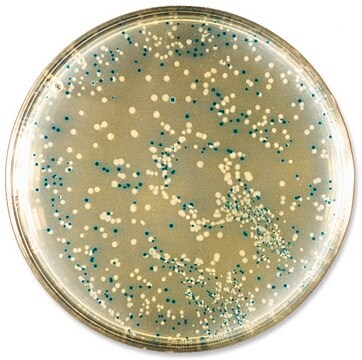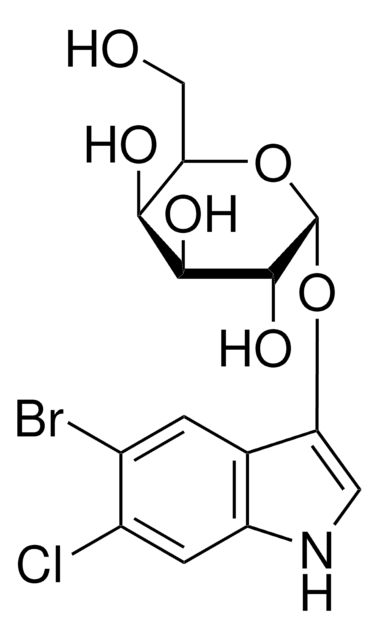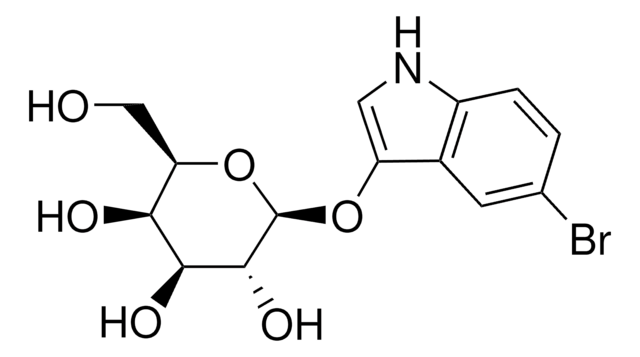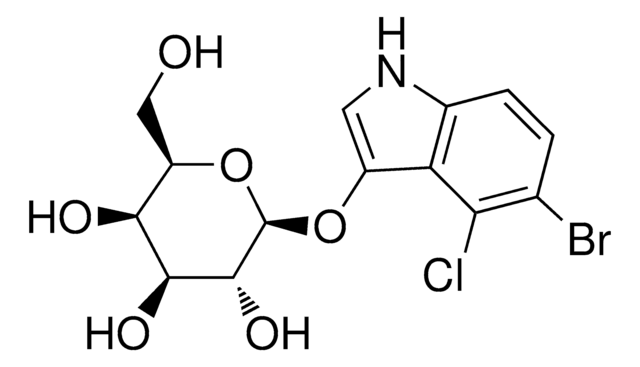推荐产品
等級
for molecular biology
無菌
non-sterile
形狀
powder
技術
microbiological culture: suitable
適合性
suitable for β-galactosidase test
nonselective for Escherichia coli
nonselective for coliforms
應用
food and beverages
microbiology
儲存溫度
room temp
一般說明
S-Gal® (sodium salt) is an autoclavable, water-soluble, chromogenic substrate for β-galactosidase, used to determine the presence or absence of a cloned DNA insert in bacteria growing on agar plates. S-gal® is designed to replace X-Gal in blue-white selection of recombinant bacterial colonies with the lac+ phenotype.
應用
S-Gal®/LB Agar Blend has been used for the identification of recombinant bacterial colonies.
Suitable for use in selection of recombinant bacterial colonies with the lac+ phenotype. S-Gal® (sodium salt) is water-soluble, autoclavable and can be added to bacterial broth containing agar prior to autoclaving.
特點和優勢
- More intense color contrast than X-gal
- Water-soluble and autoclavable for easiest use
- Convenient, pre-mixed media
成分
Ingredients (g/L)
Tryptone, 10
Yeast extract, 5
Sodium chloride, 10
Agar, 12
S-Gal, 0.3
Ferric ammonium citrate, 0.5
IPTG, 0.03
Tryptone, 10
Yeast extract, 5
Sodium chloride, 10
Agar, 12
S-Gal, 0.3
Ferric ammonium citrate, 0.5
IPTG, 0.03
原則
When S-Gal® is cleaved by β-galactosidase, the resulting product will chelate ferric ion to create a black, insoluble precipitate. Lac+ colonies grown in the presence of S-Gal® and ferric ion turn an intense black color, allowing for easy differentiation between lac+ and lac- colonies.
準備報告
Suspend contents of one packet in 500 ml distilled or deionized water. Sterilize by autoclaving for 15 to 20 minutes at 121-124°C. For microwaving, heat suspended mix until initial boiling. Mix well. Heat for short intervals with mixing until agar component is in solution. Do not allow boiling for extended periods of time. Antibiotics should be added following autoclaving or microwaving, after cooling to 48-52°C.
其他說明
The ferric or Fe3+ ion is required for color development and must be added to any S-Gal®
formulation. A medium prepared with S-Gal® is moderately dark due to the presence of ferric ammonium citrate. This darker background often provides enhanced contrast for automated colony counting or isolation.
formulation. A medium prepared with S-Gal® is moderately dark due to the presence of ferric ammonium citrate. This darker background often provides enhanced contrast for automated colony counting or isolation.
法律資訊
S-GAL is a registered trademark of Merck KGaA, Darmstadt, Germany
相關產品
产品编号
说明
价格
儲存類別代碼
11 - Combustible Solids
水污染物質分類(WGK)
WGK 3
閃點(°F)
Not applicable
閃點(°C)
Not applicable
個人防護裝備
Eyeshields, Gloves, type N95 (US)
其他客户在看
K Heuermann et al.
BioTechniques, 30(5), 1142-1147 (2001-05-18)
Blue/white selection is the standard method for detecting a cloned DNA fragment. In the absence of an insert, uninterrupted expression of the vector-encoded alpha-complement of beta-galactosidase (beta-gal), results in the hydrolysis of X-gal (5-bromo-4-chloro-3-indolyl-beta-D-galactoside) and the subsequent blue staining of
Differential expression of alphaB-crystallin and Hsp27-1 in anaplastic thyroid carcinomas because of tumor-specific alphaB-crystallin gene (CRYAB) silencing
Mineva I, et al.
Cell Stress & Chaperones, 10(3), 171-171 (2005)
N Martin Young et al.
The Journal of biological chemistry, 277(45), 42530-42539 (2002-08-21)
Mass spectrometry investigations of partially purified Campylobacter jejuni protein PEB3 showed it to be partially modified with an Asn-linked glycan with a mass of 1406 Da and composed of one hexose, five N-acetylhexosamines and a species of mass 228 Da
Heat shock protein 70 (Hsp70) subtype expression in neuroendocrine tissue and identification of a neuroendocrine tumour-specific Hsp70 truncation.
Zierhut B, et al.
Endocrine-related cancer, 11(2), 377-389 (2004)
John Kelly et al.
Journal of bacteriology, 188(7), 2427-2434 (2006-03-21)
In eukaryotes, N-linked protein glycosylation is a universal modification involving addition of preformed oligosaccharides to select Asn-Xaa-Ser/Thr motifs and influencing multiple biological events. We recently demonstrated that Campylobacter jejuni is the first member of the Bacteria to possess an N-linked
我们的科学家团队拥有各种研究领域经验,包括生命科学、材料科学、化学合成、色谱、分析及许多其他领域.
联系技术服务部门








